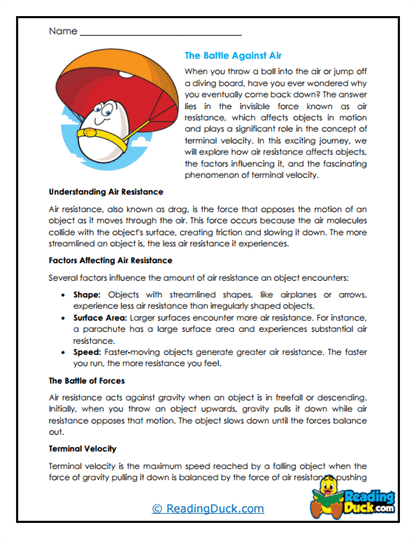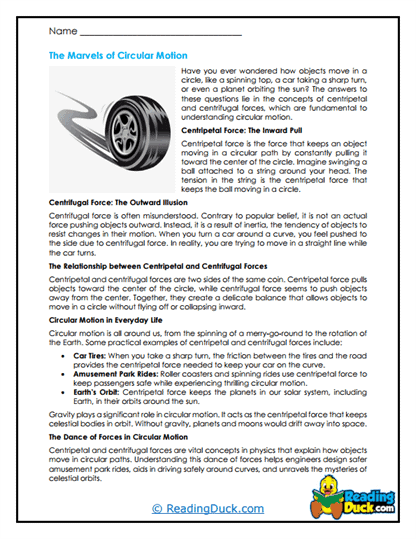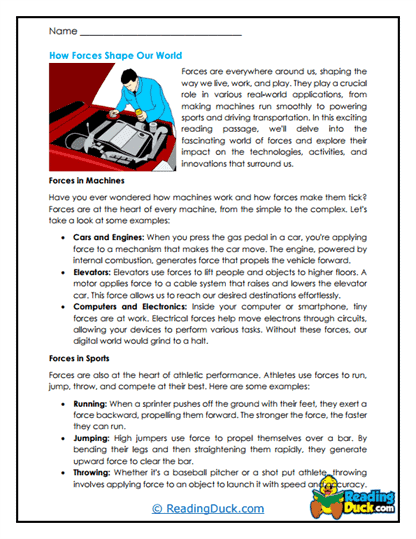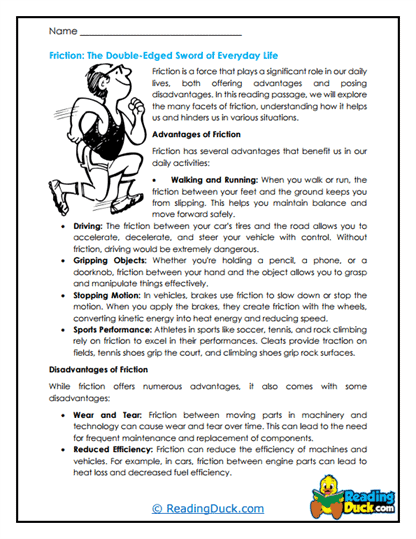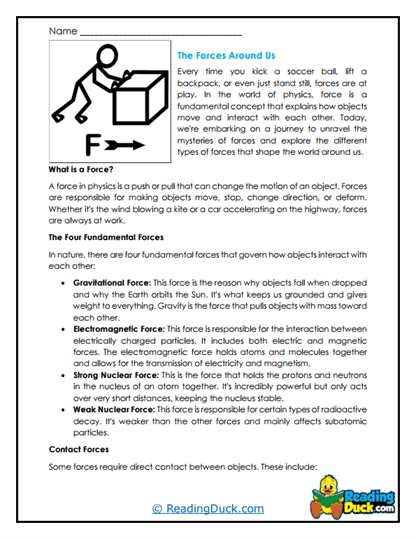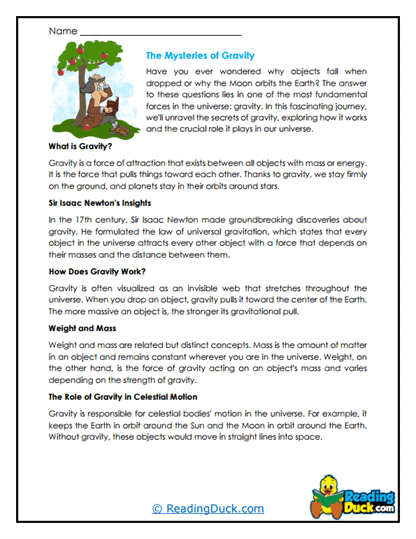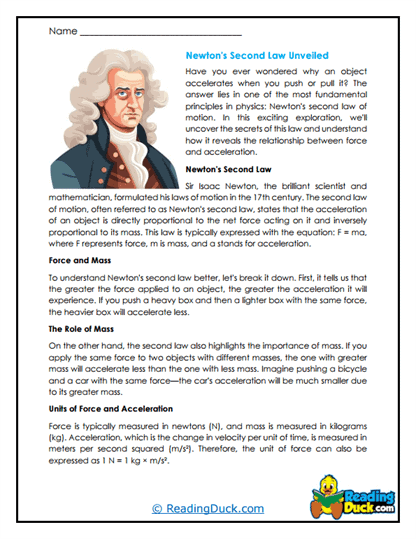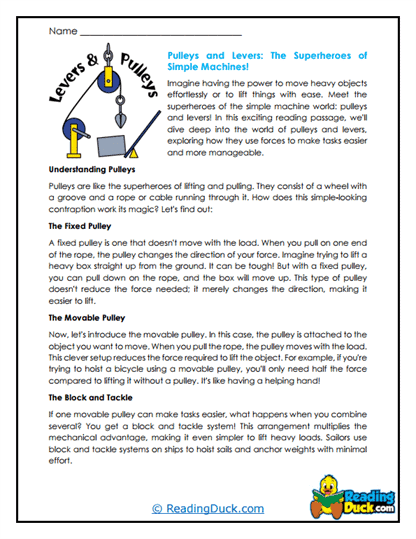Force and Motion Worksheets
About Our Force and Motion Worksheets
Our Force and Motion worksheets provide students with an in-depth exploration of the fundamental principles of physics. This collection introduces students to the concepts of force, motion, gravity, friction, and the laws that govern how objects move. These worksheets serve as a valuable resource for building a solid foundation in physics, making complex ideas accessible and engaging.
Each worksheet set includes:
- Multiple Choice Questions: These questions reinforce key concepts by testing students' understanding in a clear and straightforward format, ensuring they grasp the essential ideas presented in each reading passage.
- Short Answer Questions: These prompts encourage students to express their understanding in their own words, helping them to solidify their comprehension and think critically about the material.
- Open-Ended Questions: These questions invite students to reflect on what they've learned, offering their personal insights, opinions, and connections to real-life situations.
An answer key is provided for every question sheet to support both teachers and students. The worksheets are available as PDF files, which can be easily viewed electronically, downloaded, and printed out for use in classrooms or at home.
Understanding Force and Motion: The Basics of How the World Moves
1. What is Force?
- Defining Force:
- Force is a push or pull that can cause an object to move, stop, or change direction. It is the fundamental concept that underlies all motion. Students learn that forces can be categorized as contact forces, like friction and tension, or non-contact forces, like gravity and magnetism. Understanding force is crucial for explaining how objects interact and move in the world around us.
- Types of Forces:
- There are several types of forces that students will explore, including gravitational force, which pulls objects toward the Earth; frictional force, which opposes motion between two surfaces; and applied force, which is a force that is applied to an object by another object or person. These concepts help students understand the various ways forces affect motion in everyday life.
2. Newton’s Laws of Motion
- The First Law - Inertia:
- Newton's First Law, also known as the Law of Inertia, states that an object at rest stays at rest and an object in motion stays in motion unless acted on by an external force. This law explains why seat belts are essential in vehicles and why objects don't change their state of motion without a reason. Students learn how inertia impacts their daily lives and the movement of objects around them.
- The Second Law - Force and Acceleration:
- Newton's Second Law explains how the acceleration of an object depends on the mass of the object and the force applied to it. This relationship is described by the equation F=ma (Force equals mass times acceleration). Students explore real-life examples, such as why heavier objects require more force to move or stop compared to lighter ones.
- The Third Law - Action and Reaction:
- Newton’s Third Law states that for every action, there is an equal and opposite reaction. This law is observed in activities like jumping, where the force exerted by the legs pushes down on the ground, and the ground pushes back with an equal force, propelling the jumper upwards. This concept helps students understand the interactions between objects and how forces come in pairs.
3. Motion and Its Types
- Linear Motion:
- Linear motion refers to the movement of an object along a straight path. Students study examples like a car driving on a straight road or a ball rolling in a straight line. Understanding linear motion helps students grasp the basic concepts of speed, velocity, and acceleration.
- Rotational Motion:
- Rotational motion occurs when an object spins around an axis. Students learn about objects in rotational motion, such as wheels, spinning tops, and planets. This type of motion introduces them to concepts like angular velocity and centripetal force, expanding their understanding of how different motions work.
- Projectile Motion:
- Projectile motion describes the curved path an object follows when it is thrown or propelled near the Earth’s surface. This type of motion combines both linear and vertical motion, as seen in activities like throwing a ball or launching a rocket. Understanding projectile motion helps students predict and analyze the trajectories of objects.
4. Gravity: The Force That Pulls Us Together
- What is Gravity?
- Gravity is the force that attracts objects toward each other. On Earth, it’s the reason why objects fall to the ground and why we stay anchored to the planet's surface. Students explore the concept of gravity, learning how it not only affects objects on Earth but also governs the motion of planets, moons, and stars in the universe.
- Effects of Gravity:
- Gravity affects everything from the way we walk to how tides are formed. Students learn about the gravitational pull of the Earth, the Moon, and the Sun, and how gravity is a key factor in the orbits of celestial bodies. This section deepens their understanding of how gravity shapes our world and the broader universe.
5. Friction: The Force That Opposes Motion
- Understanding Friction:
- Friction is a force that opposes the motion of objects sliding or rolling over a surface. It is a crucial concept that explains why we can walk without slipping and why cars need brakes to stop. Students explore the different types of friction, such as static, sliding, and rolling friction, and their effects on motion.
- Reducing and Increasing Friction:
- Students learn about the methods used to reduce or increase friction, such as lubricants to decrease friction in machines or rough surfaces to increase friction for better grip. This knowledge is essential for understanding how to control motion in various practical situations, from driving vehicles to operating machinery.
Activities to Supplement These Worksheets
To enhance students' understanding and engagement with the concepts of force and motion, here are some activities that teachers and parents can incorporate into their lessons or homeschooling setups:
1. Creating and Testing Simple Machines
- Objective: Help students understand how simple machines like levers, pulleys, and inclined planes reduce the amount of force needed to perform tasks.
- Activity: Provide students with materials to build their own simple machines. For example, they can create a lever using a ruler and a fulcrum or a pulley using string and a spool. Students can then test how these machines make work easier by lifting objects or moving loads. This hands-on activity reinforces the principles of force and mechanical advantage.
2. Measuring Forces with Spring Scales
- Objective: Teach students how to measure force and understand the relationship between force, mass, and acceleration.
- Activity: Have students use spring scales to measure the force required to move different objects. They can compare the force needed to move the same object on different surfaces (e.g., smooth vs. rough) to explore the effects of friction. This experiment makes abstract concepts like force and friction tangible.
3. Exploring the Effects of Gravity with Free-Fall Experiments
- Objective: Demonstrate how gravity acts on objects of different masses.
- Activity: Drop objects of varying weights from the same height and observe how they fall. Students can use stopwatches to measure the time it takes for each object to hit the ground and compare their observations. This experiment helps dispel common misconceptions about gravity, such as the idea that heavier objects fall faster than lighter ones.
4. Building Balloon Rockets
- Objective: Explore Newton’s Third Law of Motion (action and reaction) in a fun and interactive way.
- Activity: Students can build balloon rockets by attaching a blown-up balloon to a straw that is threaded along a string. When the balloon is released, it propels itself along the string, demonstrating action and reaction forces. This activity visually illustrates the concepts of force and motion, making them easier for students to grasp.
5. Investigating Friction with Ramp Experiments
- Objective: Help students understand how friction affects motion on different surfaces.
- Activity: Set up a ramp and have students roll various objects down it, such as toy cars or marbles. They can experiment with different surface materials (e.g., sandpaper, cloth, smooth plastic) to see how friction changes the speed and distance traveled by the objects. This hands-on activity connects the concept of friction with real-world applications.
6. Conducting a Physics Scavenger Hunt
- Objective: Encourage students to identify examples of force and motion in their environment.
- Activity: Organize a scavenger hunt where students find and document examples of forces in action around them, such as a door closing, a ball bouncing, or leaves falling from a tree. They can photograph or draw these examples and explain the forces involved. This activity helps students recognize the relevance of physics in everyday life.
7. Simulating Planetary Orbits
- Objective: Teach students about gravitational forces and how they affect planetary motion.
- Activity: Use a model or a simulation tool to demonstrate how planets orbit the Sun due to the gravitational pull. Students can manipulate the distance of a planet from the Sun and observe how this affects its orbit. This activity provides a visual and interactive way to understand the balance of forces in the solar system.
8. Designing an Egg Drop Challenge
- Objective: Apply concepts of force, gravity, and motion to a real-world problem.
- Activity: Students design and build a protective device to prevent an egg from breaking when dropped from a height. They must consider the forces at play and use their knowledge of motion and materials to create an effective solution. This challenge fosters creativity and problem-solving skills while reinforcing scientific principles.
9. Using Technology to Explore Motion
- Objective: Leverage digital tools to analyze motion in a controlled environment.
- Activity: Utilize motion-sensing apps or video analysis software to study the motion of objects. Students can record and analyze the speed, acceleration, and force of different moving objects, allowing for detailed investigation and understanding of motion in various contexts.
10. Integrating Art with Physics: Force and Motion Diagrams
- Objective: Help students visualize and creatively express the concepts they’ve learned.
- Activity: Have students create detailed diagrams or illustrations that depict various forces in action, such as a car braking (friction), a person lifting a box (applied force), or a rocket launch (thrust). These artistic representations help solidify their understanding of the concepts while allowing for creative expression.
Significance of Understanding Force and Motion
Understanding force and motion is fundamental to grasping how the physical world operates. These concepts are at the heart of physics and are essential for explaining everything from the movement of everyday objects to the behavior of planets and galaxies. By studying force and motion, students not only gain valuable scientific knowledge but also develop critical thinking and problem-solving skills that are applicable in many areas of life. Whether they are aspiring engineers, scientists, or simply curious about how things work, a solid understanding of these principles equips students with the tools they need to explore, innovate, and succeed in a technology-driven world. Through these worksheets and supplementary activities, students are encouraged to become active learners and thinkers, making connections between the concepts they study and the world around them.
